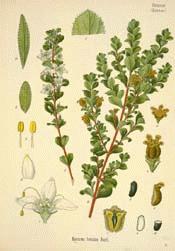
Botanical.com Home Page

|
Buchu
(Agathosma betulina)
(Barosma betulina)
Click on graphic for larger image
|
Buchu
Botanical: Barosma betulina (BART. and WENDL.)
Family: N.O. Rutaceae
---Synonym---Diosma betulina.
---Part Used---Leaves.
---Habitat---A small shrubby plant chiefly found in the south-west region of Cape Colony.
The standard Buchus of commerce are obtained from three species: Barosma betulina, known as 'shorts'; B. crenulata, known 'ovals' and 'shortbroads,' and B. serratifolia, known as 'longs.' The leaves of the firstnamed are most valued and constitute the foliea buchu of the British Pharmacopoeia.
The Hottentots use several species, all under the common name of 'Bucku.' The leaves have a rue-like smell, and are used by the natives to perfume their bodies.
Buchu leaves are collected while the plant is flowering and fruiting, and are then dried and exported from Cape Town. The bulk of the Buchu exported to London from South Africa eventually finds its way to America, where it is used in certain proprietary medicines.
---Description---The leaves of B. betulina (short Buchu) are of a pale green colour, 1/2 to 3/4 inch long, 1/2 inch or less wide, leathery and glossy, with a blunt, strongly-curved tip and finely-toothed margin, with round oil glands scattered through the leaf. Frequently the small flowers, with five whitish petals, and the brownish fruits may be found mixed with the drug. The leaves have a strongly aromatic taste and a peppermint-like odour.
[Top]
---Constituents---The principal constituents of Buchu leaves are volatile oil and mucilage, also diosphenol, which has antiseptic properties, and is considered by some to be the most important constituent of Buchu its absence from the variety known as 'Long Buchu' has led to the exclusion of the latter leaves from the British Pharmacopoeia.
The Cape Government exercises strict control over the gathering of Buchu leaves and has lately made the terms and conditions more onerous, in order to prevent the wholesale destruction of the wild plants, no person being permitted to pick or buy Buchu without a licence. Cultivation experiments with Buchu have been made from time to time by private persons, and during the war experiments were conducted at the National Botanic Gardens, Kirstenbosch (near Cape Town), the result of which (given in the South African Journal of Industries, 1919, 2, 748) indicate that, under suitable conditions, the commercial cultivation of Buchu should prove a success, B. betulina, the most valuable kind, being the species alone to be grown. The plant is particularly adapted to dry conditions, and may be cultivated on sunny hillsides where other crops will not succeed.
It is doubtful whether the cultivation of Buehu could be conducted satisfactorily outside South Africa. B. betulina was introduced to this country in 1790, but does not appear to be in eultivation at the present time, except as a greenhouse plant. This and B. serratifolia are grown in Kew Gardens.
---Medicinal Action and Uses---In gravel, inflammation and catarrh of the bladder it is specially useful. The infusion (B.P.) of 1 OZ. of leaves to 1 pint of boiling water is taken in wineglassful doses three or four times a day.
---Other Preparations---Fluid extract: dose, 1/2 to 1 drachm. Tincture, B.P.: dose, 1/2 to 1 drachm. Solid extract: dose, 5 to 15 grains. Barosmin: dose, 2 to 3 grains.
Buchu has long been known at the Cape as a stimulant tonic and remedy for stomachic troubles, where it is infused in Brandy and known as Buchu Brandy. Its use was learnt from the Hottentots.
It was introdueed into official medicine in Great Britain in 1821 as a remedy for cystitis urethritis, nephritis and catarrh of the bladder.
[Top]
Common Name Index
A MODERN HERBAL Home Page
Bear in mind "A Modern Herbal" was written with the conventional wisdom of the early 1900's. This should be taken into account as some of the information may now be considered inaccurate, or not in accordance with modern medicine.
© Copyright Protected 1995-2025 Botanical.com
|

